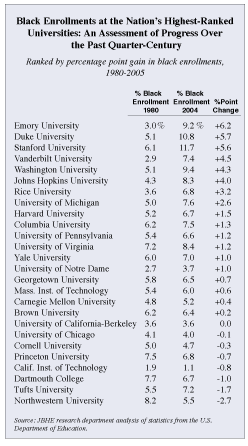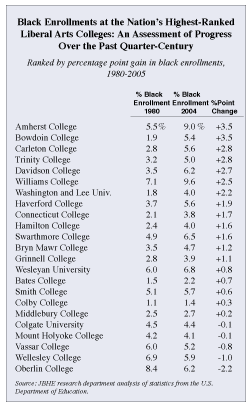| Since 1980 Black Enrollments Have Increased at All But a Few of the Nation's Highest-Ranked Colleges and Universities In the mid- to late 1960s the nation's major colleges and universities began to make strong commitments to increase the number of blacks in their student bodies. In most cases major progress was made during the 1970s. Over the past quarter-century there have been further gains. Yet there are notable laggards.
Before the late 1960s most of the nation's highest-ranked colleges and universities enrolled only token numbers of black students. Some important institutions such as Rice University in Houston, Texas, had restrictive rules prohibiting the enrollment of nonwhite students. At highly prestigious southern universities such as Duke, Emory, Vanderbilt, Chapel Hill, and the University of Virginia, there were no explicit rules prohibiting black enrollments, but the etiquette of Jim Crow was so intertwined in culture of the states that no black students even bothered to apply to these institutions. At the most highly selective colleges and universities outside the South no exclusionary rules were on the official books. But at a large number of the leading universities African-American students seeking admission were faced with the equivalent of a "Whites Only" sign on the admissions office door. Incidents such as the following were not uncommon. In the fall of 1936 Bruce M. Wright, who would later become a judge, traveled to New Jersey from his home in New York City armed with a full scholarship to Princeton University. Here in his own words is what happened to him when he arrived at Princeton: "I stood in the registration line full of hope. The sun was shining and the green lawns of the university were beautiful to behold. In my innocence I was untroubled when an upperclassman, an orange armband identifying his status, asked me to follow him to the office of the director of admissions. "I was ushered into the presence of Radcliffe Heermance. This man of Falstaffian girth towered over me. Light shafted through the leaded windows of the office. Heermance stood there, as though surrounded by a divine radiance. He was the first man to address me as 'Mr. Wright.' His next words, however, would destroy much of the child and educate me beyond anything I would ever learn in a classroom. 'We did not know you were colored when the scholarship was arranged.'" Wright was not permitted to register. He was then obliged to sit on his trunk on the sidewalk for several hours until his father drove down from New York to pick him up. Princeton did not admit its first black student until a decade later. At Vassar College in Poughkeepsie, New York, Anita Hemmings passed as white during the admissions process and throughout her college career. But in the week before she was to graduate in 1897 it was revealed she was an African American. Only after a special meeting of the college's board of trustees was Hemmings permitted to receive her diploma. Hemmings' daughter, Ellen Love, also passed herself as white and graduated from Vassar in 1923. It would be nearly two decades before Vassar knowingly admitted Negro students.
At Yale University only seven black students graduated from the undergraduate college in the 1924 to 1945 period. Harvard did a little better. At Harvard there was an unofficial quota of two or three black students in every class. It is estimated that 165 black students had enrolled at Harvard prior to World War II. The token numbers of blacks who were admitted to the elite colleges and universities in the first half of the twentieth century often faced racial indignities. In 1922 the grandson of Blanche K. Bruce, the first African American to serve in the United States Senate, came to Harvard. He, like other blacks before him, was not permitted to live in the freshman dormitories. In fact, he received a letter from Harvard President Lowell stating, "I am sure you will understand why, from the beginning, we have not thought it possible to compel men of different races to reside together." But nearly 50 years later tectonic change occurred. The civil rights unrest that took place in the mid- to late 1960s became a powerful and prime force in opening the door to blacks at most of the nation's elite colleges and universities. Contrary to general opinion, these extra-legal pressures were far more important in integrating higher education than the civil rights legislation of 1964. In some cases the racial integration of higher education was not only swift but dramatic. In 1962 there were nine black students in the freshman class at Harvard University. Five years later, in 1967, there were 55 black first-year students. In 1969 there were 121. In the 100 years between 1850 and 1950, only 45 black students had attended Yale College. In 1968 there were 31 black freshmen at Yale. The following year, in 1969, there were 96 black freshmen. In the decade of the 1970s black student enrollments increased at all of the nation's most selective institutions. Expectably, the rate of change was slower at high-ranking institutions in the South such as Duke, Rice, and Emory universities. But here, too, blacks made significant inroads during the 1970s. Gains in Modern Times Let's now turn to modern times. Here we tell the story of the progress that has occurred particularly in the post-1980 years. Over the past quarter-century the black student percentage of the total enrollments at 18 of the nation's 26 highest-ranked universities has continued to rise. Yet the percentage of black students has dropped at seven of the 26 leading institutions. But at four of these seven institutions the black percentage of total enrollments has decreased by less than one percentage point. The black percentage of total student enrollments at the University of California at Berkeley rose sharply in the 1980 to 1995 period. But since the 1997 ban on affirmative action admissions at state universities in California, black enrollments at Berkeley have plummeted. Black enrollments at Berkeley are now identical to the level that prevailed in 1980. Unlike the record of the 1970s, many of the most important increases in black student enrollments since 1980 have occurred at southern universities where initial integration efforts proceeded more slowly in the early years of affirmative action. But efforts to increase racial diversity accelerated throughout the 1980s at many of these southern institutions. For example, during the 1980 to 2004 period black student enrollments have increased most dramatically at Emory University in Atlanta where blacks now make up 9.2 percent of the student body — an increase of 6.3 percentage points since 1980. At Vanderbilt University in Nashville, the black percentage of the student body increased from 2.9 percent to 7.4 percent.
Duke University in Durham, North Carolina, also showed important gains. In 1980 blacks were 5.1 percent of the student body at Duke. Today, blacks are 10.8 percent of the student body. At Rice University in Houston, black enrollments have increased from 3.6 percent in 1980 to 6.8 percent today. This occurred during a period (1996 to 2003) when race-sensitive admissions programs at Rice were suspended due to the Hopwood ruling in Texas. Solid improvements also occurred at high-ranking universities in the former slave states of Missouri and Maryland, where early affirmative action programs may have been slow to take hold in the 1970s. Black enrollments increased from 5.1 percent in 1980 to 9.4 percent in 2004 at Washington University in St. Louis. Significant progress also took place at Johns Hopkins University in Maryland. There was a 4 percentage point improvement in black enrollments at Johns Hopkins in the 1980 to 2004 period, from 4.3 percent to 8.3 percent. In the northern and western states, the best improvement by far was at Stanford University. In 1980 blacks were 6.1 percent of all enrollments at Stanford. In 2004 the black percentage of total enrollments jumped 5.6 points to 11.7 percent. Only three high-ranking universities showed a drop in black enrollments of one percentage point or more during the 1980 to 2004 period. They were Dartmouth College, Tufts University, and Northwestern University. In 1980 Dartmouth led the Ivy League in black enrollment percentage. It has since fallen back but its overall black enrollment percentage is equal to or better than Harvard, Penn, Brown, and Cornell. The most disappointing data comes from Northwestern University. There, black enrollments have dropped from 8.2 percent in 1980 to 5.5 percent in 2004. Yet there is hope for improvement. Black first-year enrollments at Northwestern this year are 6.4 percent of the freshman class. Black Enrollment Trends at the
Since the late 1960s, the nation's elite liberal arts colleges have also competed to enroll top black students. Many of these institutions are located away from cities and black population centers in rural areas of the Northeast and Midwest, and for this reason they have a particularly difficult time attracting black students to campus. In the 1980 to 2004 period, the black percentage of the student body has increased at 18 of the 23 high-ranked liberal arts colleges in our survey. The largest percentage point increases were at Amherst and Bowdoin. Black enrollments at these two small liberal arts institutions increased by 3.5 percentage points during the period. The black enrollment percentage also increased by at least two percentage points at Carleton College, Trinity College, Davidson College, Williams College, and Washington and Lee University. The percentage of black students has declined at five of these 23 highly ranked liberal arts colleges. At Colgate and Mount Holyoke the decline was negligible. At Vassar, Wellesley, and Oberlin colleges, the percentage of blacks in the student body is indeed down from 1980 levels. But it should be noted for our comparisons that these three colleges were among the institutions with the highest percentage of black enrollments at the starting gate in 1980. Despite the decline in the black percentage of total enrollments from 1980 to 2004, all three remain today among the top tier in black enrollments. In sum, over the past quarter-century there has been solid improvement in the enrollment of black students at a majority of our leading universities and colleges. Where there have been declines, the drops in black enrollments usually have been quite small. This is indeed very good news. But we note that today blacks make up more than 10 percent of the total enrollments at only two of the 50 institutions in our survey. And we remind the reader that blacks are now more than 12 percent of the U.S. population. Therefore, despite the solid progress that has been made, blacks remain significantly underrepresented at almost all of the nation's highest-ranked colleges and universities. | |





